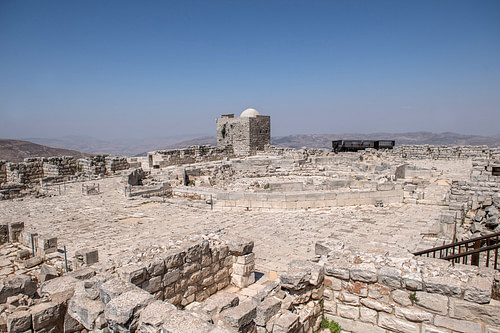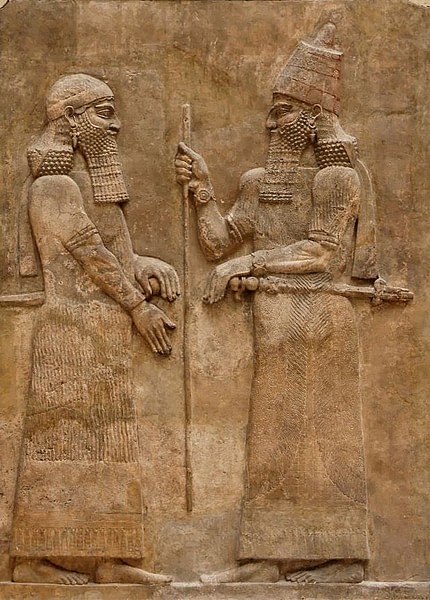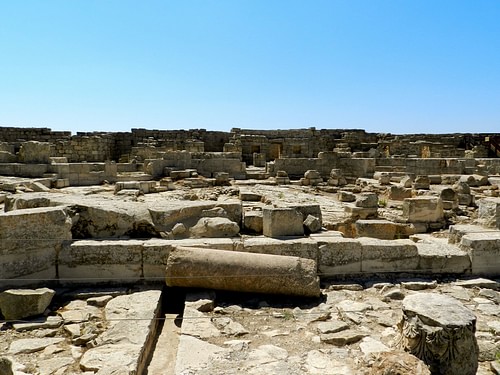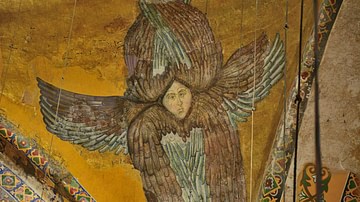
The Samaritans are a religious sect of ethnic Jews living near Mount Gerizim, Nablus, Hebron, and the West Bank in Israel. This community differs from mainstream Judaism by claiming that followers only accept the five books of Moses (Torah), and not the books of the Prophets or later texts. Referring to themselves as "keepers (guardians) of the Torah" (shomrei ha-torah), their rituals and practices are claimed to be the most ancient and valid of Jewish tradition. Hebrew shomerim may have led to the Latinized 'Samaritans'.
History
We know about the Samaritans from four sources:
- biblical books
- some Assyrian sources
- the writings of the 1st-century CE Jewish historian Flavius Josephus (36-100 CE)
- Samaritan traditions
After Moses received the ten commandments on Mount Sinai, he told the people: "When the Lord your God has brought you into the land you are entering to possess, you are to proclaim on Mount Gerizim the blessings, and on Mount Ebal the curses” (Deuteronomy 11:29).
The Book of Joshua recounts the later settlement of the tribes in Canaan. Joshua, Moses' military lieutenant, led the people and the battles for dominance in Canaan. After the tribes were subdued, a covenant-renewal ceremony took place:
Then Joshua built on Mount Ebal an altar to the Lord, the God of Israel as Moses the servant of the Lord had commanded the Israelites. ... Joshua wrote on stones a copy of the law of Moses. All the Israelites, with their elders, officials and judges, were standing on both sides of the ark of the covenant of the Lord, facing the Levitical priests who carried it. ... Half of the people stood in front of Mount Gerizim and half of them in front of Mount Ebal... Afterward, Joshua read all the words of the law—the blessings and the curses—just as it is written in the Book of the Law (Joshua 8:30-34).
In relation to genealogical ancestry, the Samaritans claim descent from two sons of Joseph, Ephraim and Manasseh.
The Two Kingdoms
King Solomon (r. 970-931 BCE), in building the first Temple in Jerusalem, conscripted labor from the twelve tribes of Israel. In this sense, many may have compared him to Pharaoh. Upon his death, ten of the tribes petitioned his son to stop the conscription, but he refused. Under the leadership of Jeroboam, these ten tribes seceded to the north and created an independent kingdom of Israel. Not wanting to lose pilgrims for the major festivals in Jerusalem, he built two temples, at Dan and Bethel. In each, he installed a 'golden calf' to worship. The city of Samaria was the capital of the Northern Kingdom.
The two tribes of Benjamin and Judah remained the Southern Kingdom of Judah, with Jerusalem as the capital. In 2 Kings, the reigns are evaluated by whether 'Jeroboam’s sin' remained in the land; only three Southern kings allegedly made any attempt to rid the land of idolatry.
The Assyrian Invasion
The ancient Assyrian Empire had existed in various phases from c. 2000 to 600 BCE in the area known as Mesopotamia. Nineveh became the capital city. During the Neo-Assyrian Empire (c. 900 BCE), expansion began, particularly toward the west. In control of the southern Levant, Egypt sponsored local rebellions in the area, but Sargon II (722-705 BCE) ended the Northern Kingdom of Israel. Recorded on the walls of the palace at Dur-Sharrukin, his inscription states: "In my first year ... I carried away the people of Samaria ... to the number of 27,290 ... the city I rebuilt. I made it greater than it was before."
To reduce future rebellions, the Assyrians practiced the exchange of populations. Moving their own people into Northern Israel, they drove the Jews east. The ten tribes became 'lost,' meaning lost to history. Jerusalem was placed under siege but held out under the kingship of Hezekiah and the Prophet known as 1st Isaiah.
Control by the Assyrians was overturned by the Neo-Babylonian Empire and Nebuchadnezzar II (r. 605-562 BCE). Zedekiah was appointed the last king of Judah but ultimately refused to pay tribute. Nebuchadnezzar laid siege to Jerusalem and destroyed the city and Solomon's Temple in 587 BCE. Babylon had a similar practice of prisoner exchange, although they were only concerned to take the aristocrats, priests, and other high-end officials; the lower classes were left in Judah. The others were taken to Babylon, in what became known as the time of the Babylonian exile.
Cyrus II & the Return of the Jews
Cyrus II (r. 550-530 BCE), known as Cyrus the Great, founded the Achaemenid Empire of Persia. According to 2 Chronicles 36:22-23:
In the first year of Cyrus king of Persia, in order to fulfill the word of the Lord spoken by Jeremiah, the Lord moved the heart of Cyrus king of Persia to make a proclamation throughout his realm and also to put it in writing: "This is what Cyrus king of Persia says: 'The Lord, the God of heaven, has given me all the kingdoms of the earth and he has appointed me to build a temple for him at Jerusalem in Judah. Any of his people among you may go up, and may the Lord their God be with them.'"
Providing funds for the rebuilding of the city and the Temple – the details are found in the books of Ezra and Nehemiah – two priests were placed in charge of the rebuilding. According to the story,
On that day the Book of Moses was read aloud in the hearing of the people and there it was found written that no Ammonite or Moabite should ever be admitted into the assembly of God, because they had not met the Israelites with food and water but had hired Balaam to call a curse down on them. ... When the people heard this law, they excluded from Israel all who were of foreign descent. (Nehemiah 13:1-3)
Those who had been left in the land offered to help build the Temple, but their offer was rejected. Allegedly there was a suspicion that these people, without the presence of the priests, had turned to idolatry. They went north and built their own Temple at Mt. Gerizim, near Shechem.
When Antiochus IV Epiphanes (r. 175-164 BCE), king of the Seleucid Empire, ordered the cessation of Jewish customs, the Jews revolted under the leadership of the Hasmonean Dynasty. However, the Samaritans negotiated a separate peace with Antiochus, offering to name their temple after a Greek deity as described by Flavius Josephus in his Antiquities of the Jews (12.5) and in the biblical book of 2 Maccabees (6:1-2). The later Hasmonean king, John Hyrcanus destroyed the temple and the city in 113 BCE. Under Roman rule, the city and residents became absorbed into the province of Judea.
Theology of the Samaritans
Samaritans believe that Mount Gerizim, not Jerusalem, is the sanctuary that God ordained from the beginning. They claim that the Torah was given to Moses by the God of Israel; later Rabbinical texts are rejected. The Samaritan Pentateuch (the five books of Moses) is the foundational sacred text, supplemented by historical chronicles. They believe that at the end of days, the dead will be resurrected by the Taheb, either a "restorer" or "a prophet like Moses." In relation to Passover, they have their own Haggadah (the text for the Seder ritual). Samaritans also retain a high priesthood and priests, who are considered the true interpreters of the Law.
The enmity between Jerusalem and the Samaritans is reflected in gospel references: "These twelve Jesus sent out with the following instructions: 'Do not go among the Gentiles or enter any town of the Samaritans. Go rather to the lost sheep of Israel'" (Matthew 10:5-6). They are sometimes the foil for the unbelief of the Jews in Jerusalem as in Luke's Parable of the Good Samaritan (10:25-37) and the Samaritan woman at the well (John 4:4-26). Acts 8:14-17 relates the story of the conversion of the Samaritans by the disciples Peter and John.

Later History
According to Samaritan sources, the Samaritans suffered persecution under the Christian Byzantine emperors for refusing to convert. After the Muslim conquests of the region, the Samaritans were granted the status of "people of the book." However, under the later period of the Abbasid Caliphate and under the rule of the Ottoman Empire in the 17th century, the Samaritan population in Damascus was slaughtered. This provided the impetus for many Samaritans of the Diaspora to move back to the Nablus region, which remains their center.
With the conquest of the West Bank by the state of Israel in 1967, the Samaritans became Israeli citizens. They were incorporated into the Palestinian Authority after the Oslo accords. They are the only people who retain dual Israeli-Palestinian citizenship. The Samaritans continue to practice their own holidays and rituals. Passover is a major festival celebrated on Mt. Gerizim.
Recent DNA and genome studies have determined that the Samaritan population comprises remnants of the tribes of Levi, Manasseh, and Ephraim. At the same time, many of the Muslims in the region are believed to have the same ancestors.









